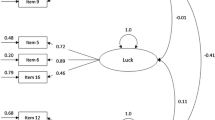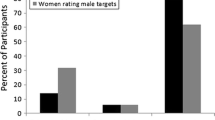Abstract
Unique invulnerability has been defined as the perception that one is less vulnerable than the average person to negative events. This study examined positive outcomes of risky behaviors with respect to unique invulnerability, taking into consideration an individual's knowledge and experience of a given risk. If the phenomenon is truly one of unique invulnerability, then we would predict either no self–other differences for positive outcomes or even an enhanced belief that more desirable outcomes would happen to oneself. We found quite the opposite. Subjects estimated that they would be less likely than others to experiencebothpositive and negative outcomes. These findings invite not only a reconsideration of unique invulnerability, but also provide important new information about risk perception within a sexual context.
Similar content being viewed by others
REFERENCES
Burger, J. M., & Burns, L. (1989). The illusion of unique invulnerability and the use of effective contraception. Personality and Social Psychology Bulletin, 14, 264–270.
Gerrard, M., Gibbons, F. X., & Bushman, B.J. (1996). Relation between perceived vulnerability to HIV and precautionary sexual behavior. Psychological Bulletin, 119, 390–409.
Gerrard, M., Gibbons, F. X., & Warner, T. D. (1991). Effects of reviewing risk-relevant behavior on perceived vulnerability among women Marines. Health Psychology, 10, 173–179.
Gerrard, M., & Warner, T. D. (1995). Comparison of Marine and college women's HIV/AIDS-relevant sexual behaviors. Journal of Applied Social Psychology, 24, 959–980.
Gibbons, F. X. (1993). Personal communication.
Klar, Y., Medding, A., & Sarel, D. (1996). Nonunique invulernability: Singular versus distributional probabilities and unrealistic optimism in comparative risk judgements. Organizational Behavior and Human Decision Processes, 67, 229–245.
Kunkel, J. H. (1991). Apathy and irresponsibility in social systems. In P. A. Lamal (Ed.), Behavioral analysis of societies and cultural practices (pp. 219–247). New York: Hemisphere.
Matthews, M. L., & Moran, A. R. (1986). Age differences in male drivers' perception of accident risk: The role of perceived driving ability. Accident Analysis and Prevention, 18, 229–313.
Moore, S., & Rosenthal, D. (1991). Adolescent invulnerability and perception of AIDS risk. Journal of Adolescent Research, 6, 164–180.
Perloff, L., & Fetzer, B. (1986). Self-other judgments and perceived vulnerability to victimization. Journal of Personality and Social Psychology, 50, 502–510.
Snyder, C. R. (1997). Unique invulnerability: A classroom demonstration in estimating personal mortality. Teaching of Psychology, 24, 197–199.
Weinstein, N. (1980). Unrealistic optimism about future life events. Journal of Personality and Social Psychology, 39, 806–820.
Whitley, B. E., Jr., & Hern, A. L. (1991). Perception of vulnerability to pregnancy and the use of effective contraception. Personality and Social Psychology Bulletin, 17, 104–110.
Author information
Authors and Affiliations
Rights and permissions
About this article
Cite this article
Dew, A.F., Henley, T.B. Reconsidering Unique Invulnerability in the Context of Sexual Behavior. Journal of Gender, Culture, and Health 4, 307–313 (1999). https://doi.org/10.1023/A:1023271505804
Issue Date:
DOI: https://doi.org/10.1023/A:1023271505804




